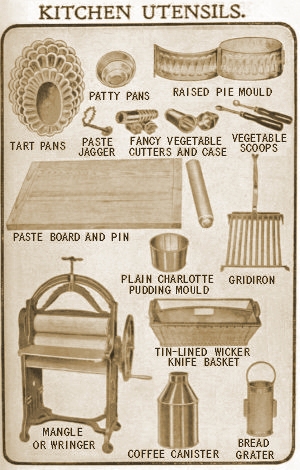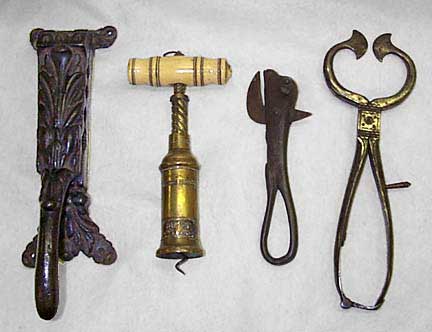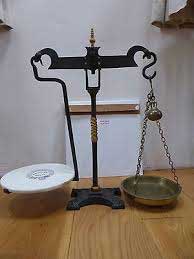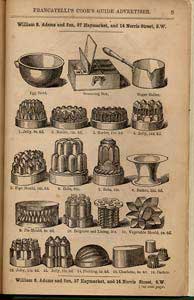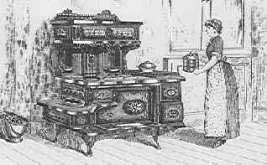Food, shop, cook 1850 - 1900
MEALS

In the early nineteenth century, for well to do people, meals still consisted of a light breakfast between 9.0 and 10.am, luncheon at about 1.0 o’clock (another light meal ) and then dinner, the main meal of the day, between 5.0 and 6.0 p.m. evening tea would be served two or three hours later and There might also be a supper served just before bedtime.
At this time, dinner was still served ‘a la francaise’ As guests entered the dining room the table would look spectacular, set out with a symmetrical display of both savoury and sweet dishes, to be followed by possibly two more ‘removes’ when the table was cleared and another complete set of different dishes served.
However during the short period of time when Marie- Antoine Careme was cooking for the Prince Regent, service ‘a la Russe’ was introduced. This involved bringing dishes to the table in sequence starting with a soup followed by fish, meat and dessert courses.The carving would be done by the host and/or his wife. The latter service giving guests at least a chance at having hot food on their plates.
Numbers of other French chefs, Alexis Soyer among them, jumping the channel as their aristocratic employers were executed during the French Revolution, also had a considerable effect on English food and style of cooking.
COOKS
It did ofcourse give great cachet to be employing a chef (French if possible) but the majority of cooks in private houses were women. They would have an assistant cook or scullery maid to help them.
There were many household management and cookery books published in the 17th and 18th century (Hannah Glasse’s The Art of Cooking Made Plain and Easy published 1746 ran to 17 editions ) and Careme led the way in the 19th century for several well known chefs to publish beautifully illustrated books stuffed with recipes culminating in the famous Isabella Beeton’s Book of Household Management first published in by her husband in his Magazine. There were also lots of recipes and hints published in weekly magazines for the lady of the house to,relay to,her servants.
By this time most middle class homes would have had a cookery book in the kitchen and a cook who could read it !
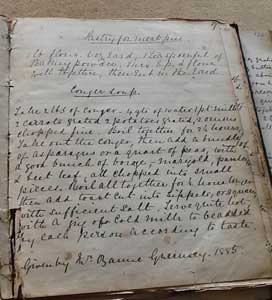
COOKING
From the peaks of sophistication in the Regency period food tended to become heavier although still highly decorated. Queen Victoria was not interested in food the way her Uncle George had been although a plenteous table was kept in her residences. After her husband died she developed a habit of eating extremely fast - no-one at table could continue to eat after she had finished so guests could go home still hungry ! The new ‘service a la Russe’ marked the beginnings of meals we would recognise today; soup, fish, meat and two veg, pudding and a savoury or cheese. The quantities that people consumed were still vast, hence the flourishing towns like Bath, Buxton and Tunbridge Wells where the well heeled could give their livers a rest cure in the summer months. Brighton too with its vigorous sea bathing was considered a very healthy place.
TECHNOLOGY
Kitchen technology slowly started to improve too as open fires began to be enclosed in cast iron with ovens and facilities for heating water included. Later in the century all kinds of kitchen tools emerged, from egg whisks to cherry pippers and apple peelers which made a cook ‘s life a little easier. Refrigeration however did not go further than ice boxes until the 1920s when General Electric released the Monitor Top, the first refrigerator to run off electricity for domestic use. Although there were all sorts of ingenious methods which attempted to keep food from going bad, generally fresh supplies had to be purchased daily.
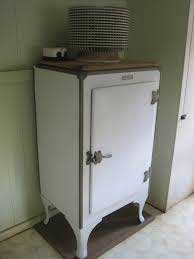
With the establishment of the British Empire, teas and coffee became less expensive although tea leaves might be used, dried, reused, dried again and the remains sold off at the back door ! Spices were also plentiful and recipes from India crept into the repertoire where they have successfully remained until today.
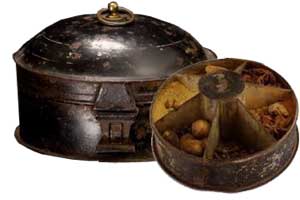
Bottled fruit
PRESERVATION
Salting, bottling and pickling with vinegar and spices were prime ways to preserve food at harvest time for the sparser winter months. Canning although pioneered rather unsuccessfully in England in was brought into home kitchens in the United States where housewives became slaves to their pressure cookers the summer long , However in its early years a can had to be opened ’ using a hammer and chisel ’ and was fraught with the possibility of poisoning anyone brave enough to eat the contents of an improperly prepared can or indeed being killed when a can exploded ! !
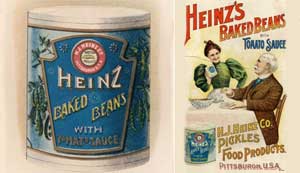
A number of preserved sauces and flavouring became available during this century notably Patum Peperium or Gentleman’s Relish ( Paris 1828) and Heinz Tomato Ketchup (U.S.A.1876) both still being manufactured today.
FOOD SUPPLIERS
Rock Street was mainly where the Estate bought its food. Grocers, green grocers, butchers and dairy all selling different types of food. Grocers’ shops sold dried goods such as tea, coffee, sugar, spices and rice; green grocers supplied fresh fruit and vegetables in season, butchers’ shops sold meat; and dairy shops sold milk, cream, eggs, butter and cheese. Coal, lamp oil, kindling and cleaning materials could also be purchased.
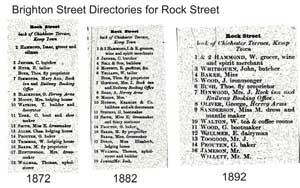
Some of the houses on the north and east sides of Sussex Square and the east side of Lewes Crescent had garden plots behind their houses. Some of these were accessed by tunnels from the cellar or garden of the house under the road. The Marquess of Bristol at 19 Sussex Square notably had a large garden in what is now Bristol Gardens; similarly No 32 Sussex Square had much the same at the other corner of the Square. Vegetables could have been grown on the plots but possibly not enough to feed a large household all the year round.
FOOD
Bread
Except in very large establishments, bread would have been baked at home. When Afternoon tea became yet another meal in itself, the cook would have to produce a good variety of cakes and biscuits to accompany scones, sandwiches to,the table.
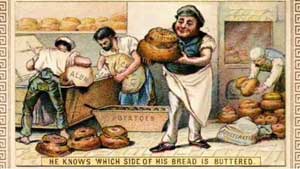
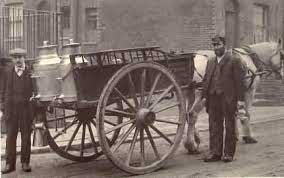
Milk although a staple was nothing like as popular as it is today. There were many ways of adulterating or stretching milk including just adding water and it did not last well with no refrigeration . In other localities milk was sometimes delivered by a milk seller who carried it in a horse drawn float or cart and the milk was ladled into jugs. In Brighton there were cowsheds scattered around the town on street corners. However on the Kemp Town Estate the Duke of Bristol built a cow shed and dairy at ( what is currently ‘Marmalade ) to produce milk for his own establishment. The surplus was sold from the dairy to residents on the Estate.
Groceries
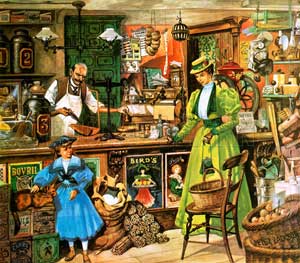
Grocers’ shops stocked butter and cheese as well but also flour, tea, coffee, sugar and rice; big houses would have bought these dry goods in bulk but for the customer wanting smaller quantities, these would be weighed at the counter and carefully wrapped in brown or grease proof paper. The shopping would be done by servants - the cook, the house keeper or ladies maid and orders would be delivered by a boy later in the day. This custom continued until the late 1950s early1960s although housewives might visit the shops themselves or telephone their orders through. In the village where I grew up the butcher would telephone weekly to discuss the week’s requirements with my mother. Choice cuts would be shared turn about among his customers. These customs changed in the 1960s when Sainsbury and Tesco introduced supermarket shopping although with the internet, history is almost repeating itself !
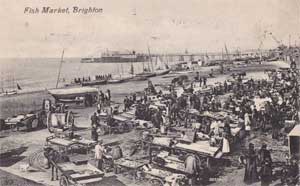
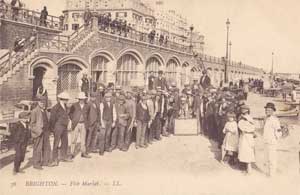
Fish
To this day fishing has always been a part of Brighton’s economy. There was a thriving fish market on the beach and the fish wives also would walk to Lewes over the Downs with their creels on their backs to market the day’s catch, no doubt lightening their load as they passed the Estate. There are still descendants of these fishing families working out of the Marina today.
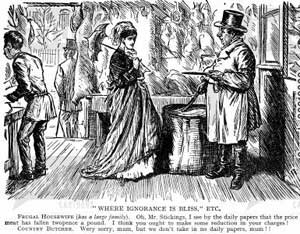
Meat
Meat was bought at the butcher - he would either buy or kill a certain number of animals every week. House wives would choose their cuts which would be delivered to their houses later in the day. This continued in country area well up into the 1960’s.
Desserts
Desserts were an important part of the meal and consisted of puddings,pies,tarts,custards creams and jellies sweetened with fruit ot sugar. The generous use of sugar showed off the hosts’ wealth - sugar grown on slave manned estates in the West Indies was expensive. A great deal of gelatine was also included as a setting agent. This was made from boilng down calves feet - a long and noisome process. One cannot help realising that the houses would have been full of the smells of cooking and baking, beside those of not very clean clothes and bodies and unsophisticated drainage systems !
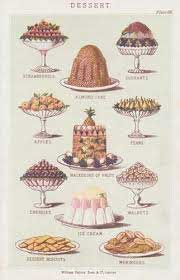
Savouries
Savouries came at the end of the meal and were usually hot and featured smoked, curried and robustly seasoned flavours. Albeit for dubious reasons. In a recent essay in food quarterly, Fire & Knives, Tom Parker-Bowles traced the origins of the savoury course back to the gentleman’s clubs of early 19th century London, where cunning chefs started serving them as a way of making customers thirsty, and selling more wine, at the end of a meal.In a domestic situation they were designed to clear the palate of sweet flavours before the port.They had some wonderful names: Devils on Horseback ( bacon wrapped prunes ),Angels on Horseback ( bacon wrapped oysters ) Scotch Woodcock (scrambled eggs and anchovies ) and Welsh Rarebit to name a few. Mrs Hannah Glasse, in her cookbook The Art of Cookery (first published in 1747 and last published in 1843), gives recipes for “Scotch rabbit”, “Welch rabbit” and two versions of “English rabbit”.
To make a Scotch rabbit, toast the bread very nicely on both sides, butter it, cut a slice of cheese about as big as the bread, toast it on both sides, and lay it on the bread.
To make a Welch rabbit, toast the bread on both sides, then toast the cheese on one side, lay it on the toast, and with a hot iron brown the other side. You may rub it over with mustard.
To make an English rabbit, toast the bread brown on both sides, lay it in a plate before the fire, pour a glass of red wine over it, and let it soak the wine up. Then cut some cheese very thin and lay it very thick over the bread, put it in a tin oven before the fire, and it will be toasted and browned presently. Serve it away hot.
CUTLERY
“The complicated dining etiquette of the Victorian era encouraged the development of utensils for eating particular foods. The proper use of cutlery formed an important and often lengthy section in all the etiquette manuals. As the century progressed, the rules for the use of some cutlery changed, reflecting the refinements that began to differentiate the manners and status of ‘old’ and ‘new’ money. The development of fish eaters is a good example of this. Until the 1880s manuals recommended that fish be eaten using two ordinary table forks or one fork and a piece of bread. Middle-class families would have bought the newly developed utensils, such as fish eaters, marking them out from those who already owned more traditional sets of cutlery.
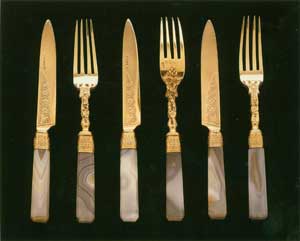
After the First World War servants and cooks became much harder to find and it was very difficult to keep a big house running with so much less ‘Help’. Restaurants became popular particularly for the rising middle classes and it was the enterprising restaurateurs and their chefs like Cesar Ritz and George Auguste Escoffier who came to London in 1890 and who became the standard bearers inventing special dishes for their favoured clientele . The Ritz and Savoy hotels were so elegant that women began to be seen dining out - hitherto an unheard of thing.
In the main however food continued to be rigorously based on the Victorian cuisine, heavy and starchy, getting ever more dull and ininteresting until the advent of the Roux brothers in the Second World War introduced the delights of French cuisine once more, The publication of Elizabeth David’s Mediterranean influenced cook books was a huge milestone in the 1950s. Finally The 1970s saw the emergence of a new British Cuisine mainly via television cooking shows with their young restaurant owning Michelin starred chefs which still head the popular programmes list today.
Vanessa Minns
